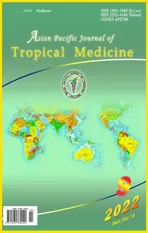An alarming scenario in developing world: A looming of viral outbreaks
2022-03-04FaheemAnwarAbdullahShazmaWahabKomalAmanIhteshamulHaq
Faheem Anwar, Abdullah, Shazma Wahab, Komal Aman, Ihteshamul Haq
1Department of Biotechnology and Genetic Engineering, Hazara University, Mansehra, 21300, KP, Pakistan
2School of Biomedical Engineering, Tianjin University, No. 92, Weijin Road, Tianjin 300072, China
3Department of Health and Biological Sciences, Abasyn University Peshawar, CEP 25000, Peshawar, Pakistan
Pakistan has suffered from various infectious diseases including dengue, Crimean-Congo hemorrhagic fever (CCHF), polio and COVID-19 in the recent past[1,2]. As per the World Health Organization reports (September 2022), 609.84 million confirmed cases have been reported globally with 6.5 million deaths. All through developing nations, Pakistan has documented the highest ratio of COVID-19 (approximately 1.5 million) cases with approximately 30 000 deaths since the first case was reported on 26th February 2020[3]. In line, dengue epidemics are at their peak during monsoons and post-monsoons season (September-October).As of September 2022, the country reported over 14 000 cases with deaths during recent flooding[4]. A study claimed that the abrupt rise in dengue cases is due to recent floods (stagnant water) in the country, which may contribute to the multiplication of larvae of Aedes. Previously, a report published by National Institute of Health(NIH) Islamabad, Pakistan, showed that the most cases of dengue infection have been detected in the last three years. From these reports, it is found that the devastating dengue epidemic strikes are mainly between March and October. However, September and October are the most effective. In 2019, an increased number of cases were reported (24 547 people) during this period. Accordingly,in September 2021, the NIH warned disease controlling authorities and health care systems about seasonal infections, which included dengue fever, leishmaniasis, and the threat of COVID-19[5]. Last October 2021, GardaWorld published a report, which claimed 25 478 cases and 60 deaths in Pakistan. Most of the cases were reported in Punjab province (12 500) followed by Khyber Pakhtunkhwa (5 107),Sindh (3 270), Islamabad (2 721) and Baluchistan (1 880)[6]. Recently,Pan American Health Organization (PAHO) documented 2.2 million cases with 1 038 deaths as of September, 2022 in Americas[7].
Likewise, cases of CCHF are also reported in the recent couple of years since the first case (1976-2010). According to authors,CCHF has been endemic across the country since 2010. A series of epidemics were experienced after the first case in 34 years (1976-2010). In 2012, 62 confirmed with 18 death cases, 100 in 2013, 34 in 2014, 25 in 2015, 78 during 2017 and 2018, 376 during 2019 and 2020, and 13 cases in June 2022[8]. Demographic data confirmed that majority of the cases belong to rural area of the country, having common occupation of herding cattle which could not have proper education, poverty, weak infrastructure, and lack of health livestock associated resources. The emergence of CCHF is a serious public health concern for the people in rural regions of the country.The government should facilitate cattle handlers with preventive resources and be aware of the consequences of CCHF. Moreover,it is expected that human-animal interaction during Eid-ul-Azha(religious festival of sacrificing animals) should also be monitored by the government authorities, shifting from rural regions to urban for sacrificing (slaughtering), which may increase the disease ratio[8]. Similarly, Pakistan is struggling to manage the eradication of polio, and yet to declare a polio-free country after Afghanistan and Nigeria. Since the country launched “Polio Eradication Program”in 1994, there has been immense decline in polio cases from 20 000 in the 1990s to 12 in 2018. Reports confirmed an increase in the polio cases in the last 3-4 years again in 2019, the number of cases reached to 147, followed by 84 in 2020. It was nearly close to becoming polio-free nation with only 1 polio case reported in 2021. Unfortunately, Khyber PakhtunKhwa province reported 11 cases in 2022[9]. These fluctuated numbers insight that certain flaws in the system handling the transmission of poliovirus should be resolved: (1) the health authorities must inaugurate high quality vaccination campaigns for suspected children across the country for boosting population immunity; (2) dispatch trained and dedicated healthcare workers in every corner of the country; (3) improve detection and surveillance capacities of the eradication program, and(4) develop coordination among all teams implying the formula of“one team under one roof”. In order to overcome multiple outbreaks(polydemics) of these four deadly viruses successfully, we should strengthen healthcare setups and vector control measurements(dengue), improve testing facilities, provide accurate diagnostic kits,screen travelers acquiring communicable diseases in airports, and establish immunization centers of vaccinations in remote areas.
Dealing with multiple outbreaks at a time can panic the healthcare setup of Pakistan in many ways. Being a developing country,Pakistan is suffering from social-economic constraints, unavailability of sufficient hospitals (1 276), beds for patients, and lack of doctors in the hospitals[4]. Dealing with outbreaks of these viral diseases, the integrated coordinated approaches are required for the governmental organizations. In order to reduce the risk of these emerging pathogens, there is greater need to understand pathogen-hostenvironment interactions.
Conflict of interest statement
The authors declare that there is no conflict of interest.
杂志排行
Asian Pacific Journal of Tropical Medicine的其它文章
- Will COVID-19 vaccination rates for children be still low in the future?
- A looming twindemic of COVID-19 and dengue on post-flood scenario in the developing countries
- Recurrent Marburg virus disease outbreaks from 1967 to 2022: A perspective on challenges imposed and future implications
- Acute motor axonal neuropathy following anti-rabies human diploid cell vaccine: A rare case and review
